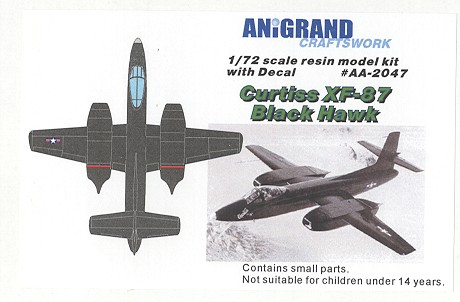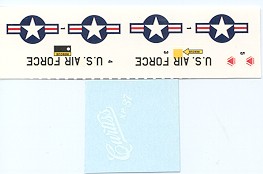
| KIT: | Anigrand Craftworks 1/72 Curtiss XF-87 'Blackhawk' |
| KIT #: | AA-2047 |
| PRICE: | $58.00 from Nostalgic Plastic (Free US Shipping) |
| DECALS: | One option |
| REVIEWER: | Scott Van Aken |
| NOTES: | Resin kit with vac canopy |

| HISTORY |
In March 1945, USAAF issued requirement for the first jet-powered attack aircraft. Curtiss submitted the Model 29 and was awarded contract for two prototypes, designated XA-43. In November 1945, before the prototype was started, Curtiss also proposed the same model to the USAAF's all-weather night fighter competition as a replacement for the P-61 Black Widow. The USAAF accepted the proposal and re-designated the project as XP-87, in competition with the Northrop XP-89 Scorpion. The first prototype was rolled out in August 1947. After a year of ground tests, the first flight was made. The project was again re-designated (for a new Fighter designation system) as XF-87. The XF-87 was judged as satisfactory but the top speed was slower than expected. In the fall of 1948, the USAF announced the F-89 as the winner of the contest. They cancelled the second XF-87 prototype and the production orders. The XF-87 was Curtiss' first pure jet aircraft, and also the company's last produced standard aircraft before Curtiss was sold to North American Aviation.
| THE KIT |
 The kit is typical Anigrand. It is molded in a buff resin with somewhat deep engraved panel lines. The quality of the resin in this kit is better than some of the previous releases in that there are very few molding glitches. I found only a couple of air bubbles and a few areas were the sprue stubs had broken chunks out of the part. From what I've seen from the last few kits, it seems as if the quality control is improving.
The kit is typical Anigrand. It is molded in a buff resin with somewhat deep engraved panel lines. The quality of the resin in this kit is better than some of the previous releases in that there are very few molding glitches. I found only a couple of air bubbles and a few areas were the sprue stubs had broken chunks out of the part. From what I've seen from the last few kits, it seems as if the quality control is improving.
The kit is really quite large and barely fits into the box, mainly due to the size of the one piece fuselage halves. You get a pretty good representation of the aircraft's seats and control stick for the cockpit. A single, rather large transparency covers the cockpit section. Typical of Anigrand vac canopies, it is difficult to see the frame lines when masking so care needs to be taken. Only one transparency is provided. The rest of the resin parts look to be well done. I am concerned that there will be some deformation of the nose gear after time from the weight of the kit. This is due to the design of the nose gear leg as much as anything. The engines have an insert for the compressor faces and though it may be difficult to remove the seam line from the gear wells, test fitting showed no problems. A nice touch is that the wings and tail planes are keyed for their join surfaces. The gear doors are molded closed so will need to be cut for the gear down option.
of the nose gear leg as much as anything. The engines have an insert for the compressor faces and though it may be difficult to remove the seam line from the gear wells, test fitting showed no problems. A nice touch is that the wings and tail planes are keyed for their join surfaces. The gear doors are molded closed so will need to be cut for the gear down option.
The instructions consist of a single sheet of folded paper. On one side is a history and photo of the aircraft along with an exploded view of the kit and parts list. The other side has a nicely drawn three view for the painting and decal guide. There are markings for one aircraft, and that basically consists of insignia from another sheet and the Curtiss XF-87 logo. Apparently the aircraft never carried a serial number. There are photos of this aircraft at other time periods that show this logo on the nose as well as on the fin. Those needing another decal sheet or set of transparencies can get them from Nostalgic plastic rather than have to order them from Hong Kong.
| CONCLUSIONS |
I love these 40's and 50's prototypes. It was an era of experimentation and so basically anything went. The only other XF-87 done was a very basic vacuformed kit by Execuform. While this aircraft is pretty normal aside from its size and engines, it is still a very cool looking aircraft and is currently underway on the bench, so stay tuned for a full build review.
| REFERENCES |
Kit Instructions.
December 2005
Many thanks to for Nostalgic Plastic the review sample. Get yours direct.
If you would like your product reviewed fairly and quickly by asite that has over 300,000 visitors a month, please contactme or see other details in the